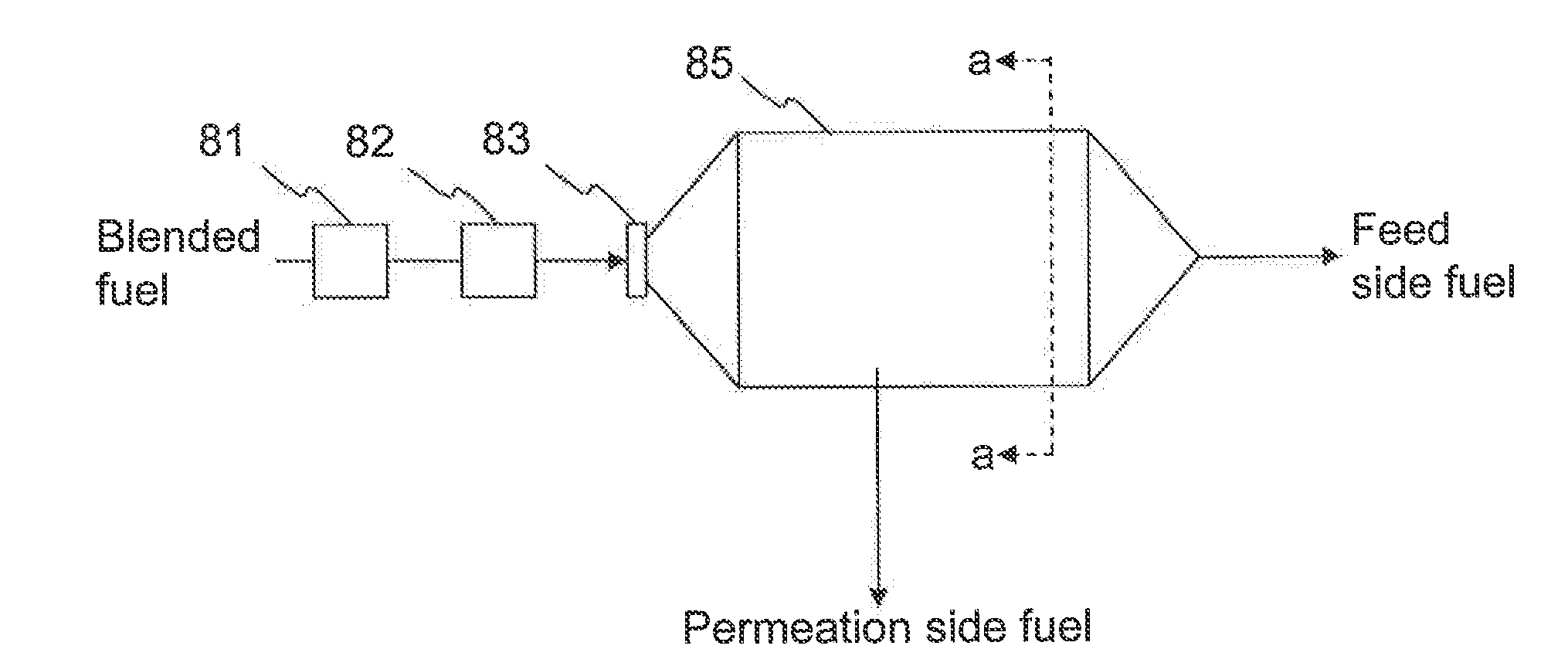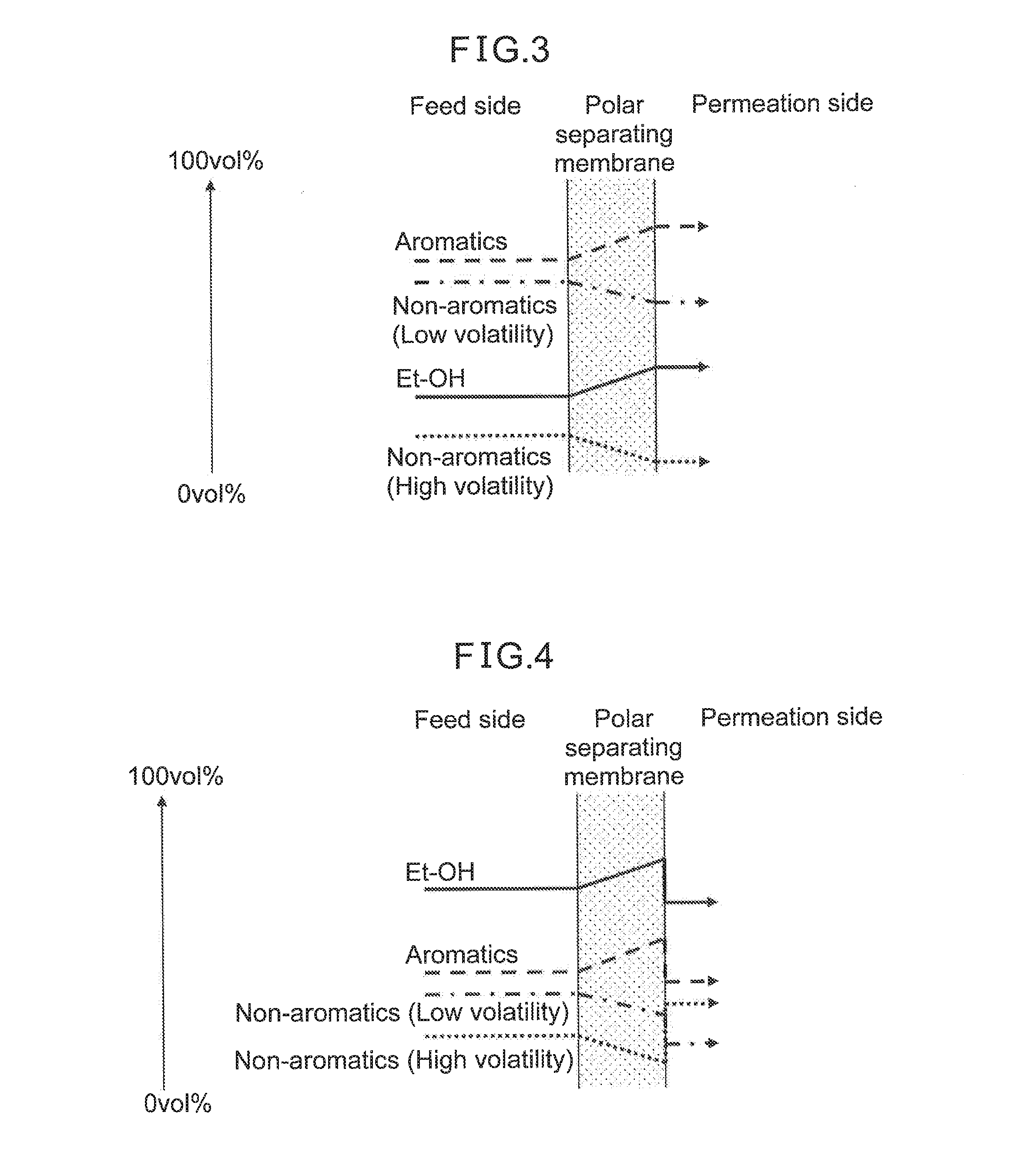Fuel separation method
a technology of fuel separation and fuel, which is applied in the direction of machines/engines, mechanical equipment, and membranes, etc., can solve the problems of low start-up property of ethanol and achieve the effect of wide compositional rang
- Summary
- Abstract
- Description
- Claims
- Application Information
AI Technical Summary
Benefits of technology
Problems solved by technology
Method used
Image
Examples
example 1
[0086]In this example, the device illustrated in FIG. 8 was used to separate an E10 ethanol-blended gasoline fuel, as a mixture of approximately 10 vol % ethanol and approximately 90 vol % gasoline, at a separation temperature of 148° C. The polar separating membrane member used consisted of a D400-DENO aliphatic epoxy crosslinked polyetheramine on a porous ceramic support, as described in U.S. Provisional Patent Application Ser. No. 61 / 476,988. The evaluation results are shown in Table 1 below.
TABLE 1Results of membrane separation of E10 fuel at 148° C.BeforeAfter membranemembraneseparation (wt %)separationPermeationFeed(wt %)sidesideComponentNon-aromatic17919high-volatilitygasoline componentsNon-aromatic523757low-volatilitygasoline componentsAromatic gasoline212919componentsEthalnol component1045Total Yield (wt %)1002476EvaluationReid vapor pressure (psi)859Octane value (RON*)MediumHighLow(92)(101)(69)(RON*): Research Octane Number
[0087]As clearly seen in Table 1, membrane separat...
example 2
[0088]In this example, the device illustrated in FIG. 8 was used to separate an E70 ethanol-blended gasoline fuel, as a mixture of approximately 70 vol % ethanol and approximately 30 vol % gasoline, at a separation temperature of 85° C. The evaluation results are shown in Table 2 below.
TABLE 2Results of membrane separation of E70 fuel at 85° C.BeforeAfter membranemembraneseparation (wt %)separationPermeationFeed(wt %)sidesideComponentNon-aromatic685high-volatilitygasoline componentsNon-aromatic17920low-volatilitygasoline componentsAromatic gasoline10511componentsEthanol component677864Total Yield (wt %)1002773EvaluationReid vapor pressure (psi)5.67.55.5Octane valueHighHighHigh
[0089]As clearly seen in Table 2, membrane separation at a relatively low temperature of 85° C. in Example 2 made it possible to increase the proportion of non-aromatic high-volatile gasoline components, and thereby increase the Reid vapor pressure value, in the blended gasoline fuel obtained at the permeation ...
PUM
| Property | Measurement | Unit |
|---|---|---|
| temperature | aaaaa | aaaaa |
| pressure | aaaaa | aaaaa |
| temperature | aaaaa | aaaaa |
Abstract
Description
Claims
Application Information
 Login to View More
Login to View More - R&D
- Intellectual Property
- Life Sciences
- Materials
- Tech Scout
- Unparalleled Data Quality
- Higher Quality Content
- 60% Fewer Hallucinations
Browse by: Latest US Patents, China's latest patents, Technical Efficacy Thesaurus, Application Domain, Technology Topic, Popular Technical Reports.
© 2025 PatSnap. All rights reserved.Legal|Privacy policy|Modern Slavery Act Transparency Statement|Sitemap|About US| Contact US: help@patsnap.com



